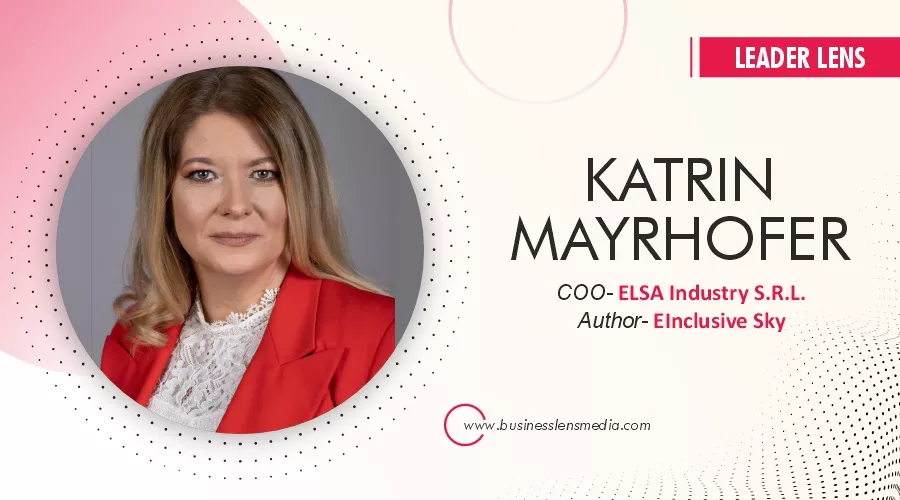By Katrin Mayrhofer, COO of ELSA Industry S.R.L. and author of “Inclusive Sky” – she possesses a unique perspective on the convergence of conventional and next-generation aviation.
With 15+ years in aviation, spanning from AIM Service Provider roles and work with conventional helicopters like RACER, to cutting-edge Advanced Air Mobility (AAM) projects such as HARPY or LeVanta Tech’s HALIA, my daily work at ELSA Industry navigates the intersection of proven rotorcraft technology and revolutionary innovation. The helicopter remains a remarkable machine, yet it cannot single-handedly meet the escalating demands of modern air mobility. The debate should not be framed as an Either-Or conflict between old and new technologies but rather an intelligent fusion of their strengths. The true breakthrough is collaboration — a necessity to address critical challenges, from disaster response to delivering inclusive urban mobility solutions.
Since Igor Sikorsky’s pioneering helicopter in the 1930s, rotorcraft have been indispensable. Their achievements include millions of lives saved in rescue missions, transport of cargo to remote oil platforms, reconnaissance in defense, and vital roles in air rescue. The mechanical complexity of helicopters is the result of decades of meticulous refinement — every component embodies deep engineering expertise. However, conventional helicopters face operational limits that cannot be ignored:
Technical & Economic Limits
- Noise: Helicopters generate 95-110 dB, posing integration challenges in dense urban areas due to community noise protests.
- Cost: Operating expenses range from €600 to €2,000 per flight hour, limiting economic viability for many missions.
- Maintenance: Military models can require 10-15 maintenance hours per flight hour, restricting scalability.
- Environmental Impact: Consuming 150-400 liters of kerosene per hour contradicts European climate goals.
Human & Safety Limits
- Pilot Workload: Urban complexity and poor visibility push pilots to physiological limits.
- Safety Risks: Mechanical complexity heightens risk of catastrophic failures.
- Human Lives at Risk: Rescue crews face extreme danger during natural disasters, with incidents like helicopter crashes in wildfire zones underscoring the stakes.
AAM as a Complementary Force – Beyond Electric Helicopters: AAM extends far beyond electric vertical take-off and landing (eVTOL) aircraft. Its scope includes unmanned cargo drones, autonomous passenger systems, and novel airspace management concepts. Unlike helicopters, AAM employs distributed propulsion with multiple motors replacing complex gearboxes, fly-by-wire electronic controls for precise flights, autonomy from assisted to fully autonomous modes, and electric propulsion promoting lower emissions and noise.
Where AAM Already Excels Today
Disaster Response – Unmanned systems revolutionize operations by:
- Surveying hazardous or inaccessible areas.
- Delivering medication and survival supplies.
- Detecting wildfires early and monitoring fire spread.
- Locating missing persons in avalanches or floods.
These missions safeguard rescue personnel by minimizing their exposure to danger.
Urban Mobility – eVTOLs offer advantages:
- Lower noise emissions (~65-75 dB vs. 95-110 dB for conventional helicopters) facilitate urban use.
- Point-to-point services negate the need for costly airport infrastructure expansions.
- Capacity scalability is achieved via high frequency rather than increasing aircraft size.
The Economic Challenge: Why Air Taxis Struggle: Despite technological promise, large economic hurdles remain:
- Acquisition $1-5 million per eVTOL unit.
- Infrastructure €5-20 million per urban vertiport.
- Certification Up to $1 billion for new aircraft types.
- Operating Costs Economic viability uncertain with limited initial capacity.
Air taxi concepts targeting only affluent users risk failure in Europe, where cultural, political, and regulatory realities demand socially just systems:
- Social justice and ecological sustainability are core values.
- EU initiatives like the “Green Deal”and “AccessibleEU” mandate inclusivity.
- Market size for elite-only service is too limited for profitability.
The European Solution: Inclusion Instead of Elite Thinking – Insights from “Inclusive Sky”
My book advocates for a DEI (Diversity, Equity, Inclusion) approach as foundational:
- Larger markets through accessibility for people with mobility impairments.
- Enhanced innovation via diverse development teams.
- Broader societal and political acceptance.
Practical Implementation
- Air taxis must integrate into multimodal public transport apps (e.g., DB Navigator, Moovit).
- Fare systems should be seamless, using public transport tickets.
- Vertiports ought to connect with train stations and transport hubs.
Use Cases for Inclusive Mobility
- Rural medical outreach delivering doctors and medication.
- Urgent emergency medicine transport.
- Affordable commuter connections between suburbs and economic centers.
- Wheelchair-accessible cabin designs from the outset.
Inclusion boosts profitability by increasing utilization, eligibility for subsidies, economies of scale, and integration into public transport budgets.
The Convergence Playbook: Collaborative Development Framework
Shared Infrastructure – Digital and physical assets must serve helicopters and AAM aircraft alike:
- U-Space/UTM airspace management must accommodate both.
- Communication protocols need harmonization.
- Emergency systems should operate jointly.
Vertiport Design – Universal charging stations compatible with multiple vehicle types.
- Shared maintenance and emergency power infrastructure for disaster response.
Technology Cross-Pollination
- From AAM: battery tech for hybrid helicopters, lightweight composites, autonomous pilot assistance.
- From Helicopters: certification expertise, safety frameworks, operational experience.
Unified Safety Culture
- Common aviation safety standards.
- Transparency of incident data across platforms.
- Continuous improvement with shared lessons.
Practical Applications Where Synergies Save Lives
Scenario 1: Wildfire Fighting Integration
- Early morning drone fleet launches enable rapid fire detection.
- Real-time fire front mapping by unmanned swarms.
- Helicopter teams deployed strategically.
- eVTOLs deliver spare parts and supplies.
- Autonomous drones transport heavy gear to difficult terrain.
Outcome: Faster, safer, and more precise firefighting.
Scenario 2: Urban Mobility 2030
- Commuter books eVTOL via public transport app.
- eVTOL transports multiple passengers to train station.
- Transfers to urban rail to final destination.
- Business traveler flows directly to regional airport via eVTOL.
- Rescue helicopter operates in same airspace for urgent missions.
Outcome: Efficient infrastructure use and equitable mobility access.
Conclusion: One Sky, One Ecosystem
The false dichotomy of “AAM vs. Helicopter” distracts from the true mission: leveraging each technology’s strengths together for societal benefit. By 2040, helicopters remain crucial for heavy loads, long distances, and complex rescues, complemented by scalable, rapid AAM systems prioritizing human safety and accessibility.
This future requires brave leadership, collaboration, and a commitment to inclusion. Advanced mobility is not a privilege of the elite but a right for all. The call to industry is clear: think ecosystems, cooperate, design inclusively, and build bridges — not just machines. Together, we can forge an aviation ecosystem that honors the helicopter legacy and fulfills the promise of equitable, advanced air mobility.













